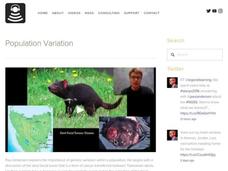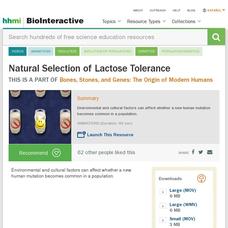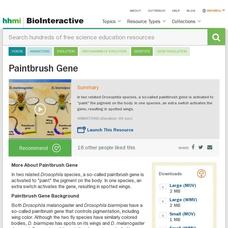PBS
The Ghostly Origins of the Big Cats
A lack of fossil records forces scientists to piece together the evolution of the big cats. The PBS Eons video lesson describes the processes scientists use to infer evolutionary details and predict possible species. Scholars get an...
Stated Clearly
What is DNA and How Does it Work?
Explaining exactly how DNA works to provide genetic information is a complex topic, but it is presented in a clear and engaging way through a five-minute video. Have learners try to explain how DNA works before watching the video, then...
Bozeman Science
Microevolution
If some genes were exposed to microwaves, would that cause microevolution? In the video, scholars learn about microevolution or any change in the allele frequency of a population. The instructor explains the five ways microevolution...
FuseSchool
What Is Cancer?
Almost 40 percent of people will have cancer at some point in their lifetime. The Fuse School Genetics video explains what cancer is and how it results in a tumor. It describes the process of cell division and mutation throughout the...
PBS
The Two People We're All Related To
Is it possible all current lineage trace back to one male and female? Mitochondria DNA suggest just that! A lesson with this interesting perspective on genetic heredity explains how all human DNA connects to a single male and female in...
TED-Ed
How to Biohack Your Cells to Fight Cancer
Is it possible to use biotechnology to trick your body into fixing cancer-causing mutations? A video presentation discusses both traditional and new technologies that fight cancer. The amazing technologies are sure to intrigue viewers as...
SciShow
Immortal Cells Turn 96
Happy Birthday, Henrietta Lacks! Celebrate August 1, the birthday of one of the most important women in genetics in part 139 of a 143-part video series. The narrator describes the life of Henrietta Lacks, the aggressive form of cancer...
Howard Hughes Medical Institute
The Birth and Death of Genes
Notothenioids are not your average fish—they contain antifreeze! An interesting video introduces the icefish, a scaleless fish with colorless blood that lives in the oceans around Antarctica. It explains how gene duplication and...
PBS
How Evolution Works (And How We Figured It Out)
The concept of evolution changed the way scientists view the world. Part of the PBS Ions series, a thorough video lesson explains the process of evolution by exploring the work of scientists like Charles Darwin and Gregor Mendel. The...
Howard Hughes Medical Institute
The Making of the Fittest: Natural Selection and Adaptation
The pocket mouse can be light brown like the sands of the desert, or dark brown like the volcanic lava flows that are interspersed throughout New Mexico's Valley of Fire. It seems that predators have weeded out light colored mice in this...
Bozeman Science
Population Variation
Tasmanian devils are scavengers who eat dead animals including the bones and fur. A video begins with cancer in Tasmanian devils to demonstrate the importance of genetic variation. Then examples such as the black-footed ferret and AIDS...
FuseSchool
Selective Breeding
Did you know that selective breeding is behind the food we're eating? Discover the agricultural practice that changed humans from foragers to farmers using an insightful video that is part of the Fuse School playlist on Evolution. Young...
Howard Hughes Medical Institute
Sickle Cell Anemia
The most common blood disorder in the United States, sickle cell impacts more than 70,000 Americans. Understanding the genetic coding that leads to this disease might one day help scientists prevent it altogether. Using a promising...
Howard Hughes Medical Institute
Natural Selection of Lactose Tolerance
Different regions of the world have greatly varying rates of lactose tolerance. Learn why this mutation spreads in some populations and not others with an educational video. Viewers consider the relationship with natural selection in...
Stated Clearly
What is Natural Selection?
Examine exactly what is meant by natural selection, as well as how it works in nature and through the assistance of humans. Presented with fun graphics and simple narration, the complex topic of natural selection is clearly explained in...
California Academy of Science
Therapy for Color Blindness
Could a virus be the key to reversing color blindness in humans? Some researchers believe so, and have even tested it out on monkeys. Learn more about the experiment and its effects in a short video that could accompany a lesson on gene...
Bozeman Science
Natural Selection
Between 1968 and 2002, the total number of peppered moths decreased by almost two thirds, although scientists do now know why. In the 10th video of the series, the instructor defines evolution as any changes to a gene pool. Scholars then...
Howard Hughes Medical Institute
Pocket Mouse Evolution
G.H. Hardy and Wilhelm Weinberg created a mathematical formula to predict genotype frequencies. Observe a simulation of the Hardy-Weinberg equation using pocket mice. Scholars consider the selection coefficient, selective advantage, and...
TED-Ed
How This Disease Changes the Shape of Your Cells
Just what exactly is sickle cell disease? A short, animated video explains how the cell adaption works, how inheriting the sickle cell trait can be an advantage in malaria-prone areas, and how sickle cell disease can be deadly.
Bozeman Science
LS3B - Variation of Traits
Make sure your unit on trait variation causes a sensation! Take an in-depth look at standard LS3B, an important component of the Next Generation Science Standards. The narrator discusses methods of delivering the standard to younger...
PBS
When Apes Conquered Europe
Where are they now? Apes are humans' closest evolutionary ancestor, yet they only live in small areas in Africa and Asia. Learn how their geography changes with evolution in a video lesson from the PBS Eon series.
PBS
How Sloths Went from the Seas to the Trees
Discover the versatility of the sloth species—at least what it once was! Scholars examine the history of the evolution of the sloth in a segment of the PBS Eons series. They learn that the current-day view of the sloth is one of a...
Howard Hughes Medical Institute
Paintbrush Gene
Drosophila includes more than 1,500 species and often find themselves studied by geneticists. A scientist presents a lecture on one example of these studies on the paintbrush gene. The gene determines the amount and color of pigment on...
Nature League
Exploring Evolution and Speciation - Lesson Plan
The first video in a five-part series on Evolution and Speciation introduces four types of evolution and addresses common misconceptions. In addition, viewers learn about topics current understanding of science does not fully explain.
Other popular searches
- Plant Genetic Mutations
- Genetic Mutations Simulation
- Cellular Genetic Mutations
- Biology Genetic Mutations
- Genetic Mutations Indiana
- Studying Genetic Mutations

























